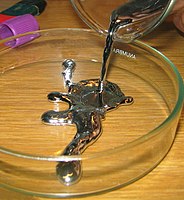
Photo from wikipedia
The MnO2/TiO2 (TM5) catalyst modified by molybdenum was used for mercury oxidation at different temperatures in a fixed-bed reactor. The addition of molybdenum into TM5 was identified as significantly enlarging… Click to show full abstract
The MnO2/TiO2 (TM5) catalyst modified by molybdenum was used for mercury oxidation at different temperatures in a fixed-bed reactor. The addition of molybdenum into TM5 was identified as significantly enlarging the optimal temperature range for mercury oxidation. The optimal mercury oxidation temperature of TM5 was only 200 ◦C, with an oxidation efficiency of 95%. However, the mercury oxidation efficiency of TM5 was lower than 60% at other temperatures. As for MnO2–MoO3/TiO2 (TM5Mo5), the mercury oxidation efficiency was above 80% at 200–350 ◦C. In particular at 250 ◦C, the mercury oxidation efficiency of TM5Mo5 was over 93%. Otherwise, the gaseous O2, which could supplement the lattice oxygen in the catalytic reaction, played an important role in the process of mercury oxidation over TM5Mo5. The results of X-ray photoelectron spectroscopy (XPS) suggested that mercury oxidized by O2 over TM5Mo5 followed the Mars–Maessen mechanism.
Journal Title: Catalysts
Year Published: 2020
Link to full text (if available)
Share on Social Media: Sign Up to like & get
recommendations!